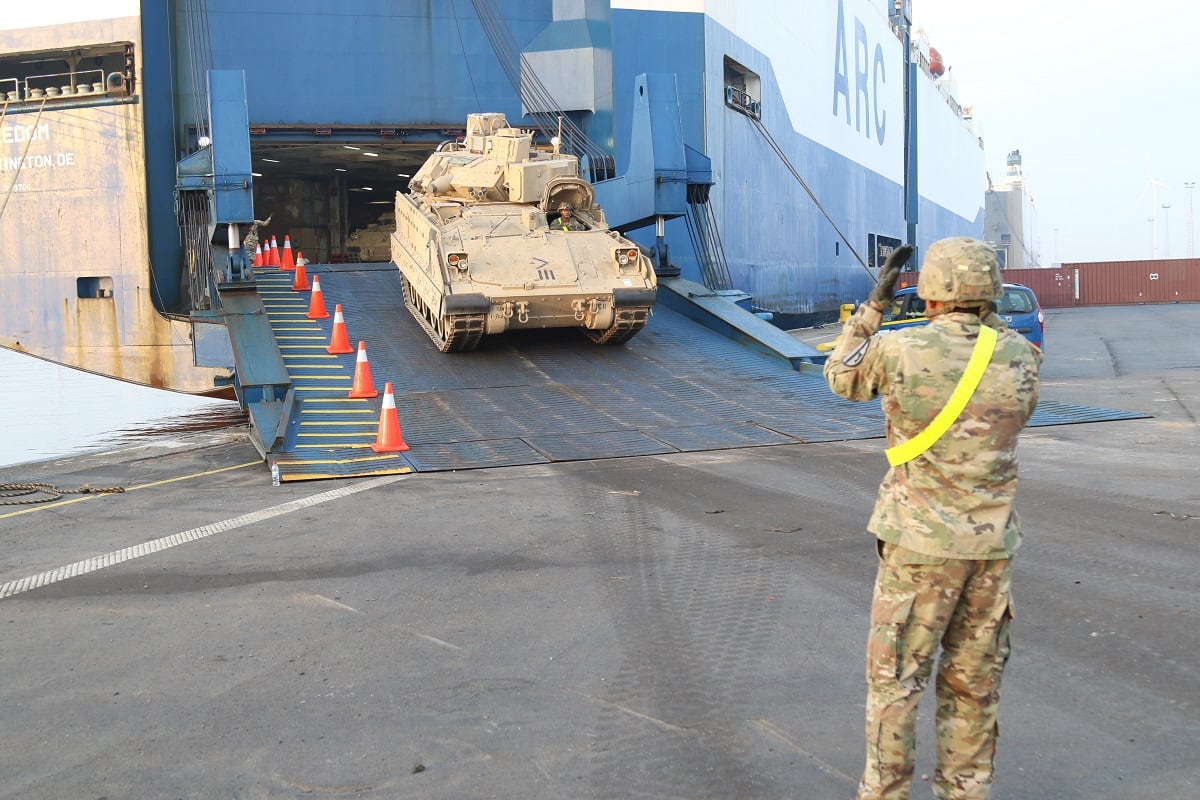WASHINGTON — The U.S. and its NATO allies are teaming up to more closely cooperate on the development and fielding of unmanned maritime systems, according to an agreement signed by the defense heads of 13 NATO allies.
During the July summit, the powers signed onto a plan to jointly pursue technologies aimed at mine and sub hunting, according to an October news release making the agreement public.
“The use of unmanned systems is a potentially game changing leap forward in maritime technology,” the release read. “Working alongside traditional naval assets, these unmanned systems will increase both our situational awareness and our control of the seas.”
The release, while short on details, seems to open up the possibility that development of underwater and surface drones could be even more lucrative for companies involved, as it hints at the alliance seeking common, interoperable systems. That means a proven drone might be competing for business in 13 markets simultaneously instead of just one.
RELATED

“Through this initiative, Allies will also be able to exploit economies of scale to reduce costs, allowing increasing defence budgets to go even further,” the release said.
The countries involved in the agreement are Belgium, Denmark, Germany, Greece, Italy, the Netherlands, Norway, Poland, Portugal, Spain, Turkey, the United Kingdom and the United States.
For NATO watchers, the agreement is the latest sign of just how seriously the alliance is taking the threat from Russian submarines.
“NATO members are alarmed by the growing threat from Russian submarines, and are investing more resources to deal with it,” said Jorge Benitez, a senior fellow at the Atlantic Council who previously served as the lead on NATO issues for the Office of the Secretary of Defense. “Under [President Vladimir] Putin, Russia has deployed new, stealthier submarines in the north Atlantic that are much harder for NATO navies to track.
“This new multinational cooperation in undersea drones is the most recent example that NATO is taking the Russian threat in the north Atlantic much more seriously than it has in the past quarter century.”
Expanding role
The agreement also reflects the ever-expanding role of unmanned systems in the underwater domain, which countries are banking on to offset the ever-quieter and more advanced submarines.
As the U.S. submarine fleet has dipped to 56 attack and guided-missile boats, and the Navy projects that number is slated to further drop to 42 by 2028 and hold below 48 boats through 2032, according to a recent Congressional Research Service report.
The Navy’s 2019 30-year shipbuilding plan shows the number of attack submarines dropping precipitously in the mid-2020s, something CRS has warned about for years as the Los Angeles-class boats begin to retire in numbers.
That shortfall is prompting an all-out push on developing unmanned systems that can perform some functions to free up the big hunters for missions where they are more needed.
When it comes to cooperating in development of drones, monitoring the littorals in and around the Baltic — and in the Greenland, Iceland and the United Kingdom gap — is an area where this kind of cooperation could be helpful, said Bryan Clark, a retired submariner and analyst with the Center for Strategic and Budgetary Assessments.
RELATED

The Battle of the Atlantic
The renewed threat from Russian submarines has triggered what the U.S. Navy’s Europe commander, Adm. James Foggo, has dubbed “The Fourth Battle of the Atlantic,” harkening back to the fight with German U-boats in World War I, World War II and the standoff with Russia in the Cold War.
But with the expansion of NATO to former Soviet satellite states, the Battle of the Atlantic will sprawl from the Eastern Seaboard all the way to the Baltic and Black seas, areas that Russia has fortified with anti-access, area denial weapons and other capabilities in recent years.
That battlespace, however, extends not only to the undersea domain but all the way to the ocean floor, which is home to everything from pop-up mines to undersea internet cables that transmit the vast majority of the world’s data.
That means the alliance will need to know more than ever about what’s on the sea floor, a job that simply can’t be done with the declining number of attack submarines needed to shadow nuclear missile subs and conduct high-risk intelligence, surveillance and reconnaissance missions around the globe.
In that arena, experts say that underwater systems — be it drones or stationary systems — will be necessary to monitor crucial chokepoints.
"We don’t have to know everything everywhere,” retired Vice Adm. Michael Connor, former head of American’s submarine forces, told the House Seapower and Projection Forces Subcommittee in a 2015 hearing. “But there are places where you would like to have very good knowledge. We have critical things we want to protect, like some of the undersea infrastructure that is so critical to our economy.
“There may be places we decide we want to have some volume of systems and that relatively small area around that infrastructure where you would have sufficient vehicles to obtain perfect knowledge.”
Pawns
Developing and using autonomous underwater unmanned vehicles has proven to be a challenge. The issues are multifarious, but they boil down to three core problems: communications, navigation and endurance.
Communicating underwater is a challenge in the best of circumstances, and surveillance drones aren’t worth much if they can’t tell others what they find. To that end, they must either have a home base to which they can navigate and upload data, or they need to surface and transmit, said Clark, the CSBA analyst.
A second challenge is navigating around obstacles. Fish, which know quite a bit about navigating underwater, have trouble avoiding commercial fishing nets that are common in sea lanes. Likewise, drones have issues finding and avoiding them, and that’s just one example.
Endurance is another challenge. Some of the best underwater drones in the U.S. Navy’s inventory, under ideal usage conditions, last a day underwater, Clark said.
“UUVs can only go a few knots, and that’s of limited duration,” he said.
Underwater drones are showing promise in the areas of mine hunting and mine sweeping, but perhaps even more promising — in terms of becoming an adequate stand-in for an attack boat — are some of the surface drones in development. Clark said programs such as the Sea Hunter, a medium-displacement unmanned surface vessel, could be a huge leap forward for monitoring chokepoints.
Developed by the Defense Advanced Research Projects Agency, the Anti-Submarine Warfare Continuous Trail Unmanned Vessel, or ACTUV, was designed to track enemy subs while avoiding collisions and abiding by the rules of the road. The first Sea Hunter was christened in 2016, and in January the project transitioned to the Office of Naval Research for further development.
The idea behind Sea Hunter is that one can field a multitude to cover a lot of area at a fraction of the cost of a frigate of destroyer.
“ACTUV represents a new vision of naval surface warfare that trades small numbers of very capable, high-value assets for large numbers of commoditized, simpler platforms that are more capable in the aggregate,” Fred Kennedy, head of DARPA’s Tactical Technology Office, said in a January news release. “The U.S. military has talked about the strategic importance of replacing ‘king’ and ‘queen’ pieces on the maritime chessboard with lots of ‘pawns,’ and ACTUV is a first step toward doing exactly that.”
Other technologies have also shown promise. Liquid Robotics’ Wave Glider, which uses ocean current and solar panels to power itself, can stay at sea for months at a time and provide persistent surveillance for anywhere from $250,000 to $300,000 a unit, a company representative told Defense News last year.
The agreement reached by 13 NATO powers is just the latest indication of how countries see unmanned systems impacting the future of warfare.
“It’s an important statement that NATO allies and partners are thinking seriously about these emerging capabilities — and they need to think about them,” said Michael Horowitz, a political science professor at the University of Pennsylvania whose research has centered on unmanned systems. “It’s a reflection of how they see these systems impacting the maritime domain.”
David B. Larter was the naval warfare reporter for Defense News.






